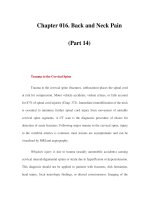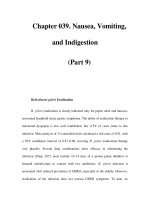Chapter 053. Eczema and Dermatitis (Part 14) ppsx
Bạn đang xem bản rút gọn của tài liệu. Xem và tải ngay bản đầy đủ của tài liệu tại đây (30.88 KB, 5 trang )
Chapter 053. Eczema and
Dermatitis
(Part 14)
Acne Rosacea
Acne rosacea, commonly referred to as rosacea, is an inflammatory
disorder predominantly affecting the central face. Those most often affected are
Caucasians of northern European background, but it is seen in patients with dark
skin also. It is seen almost exclusively in adults, only rarely affecting patients <30
years. Rosacea is more common in women, but those most severely affected are
men. It is characterized by the presence of erythema, telangiectases, and
superficial pustules (Fig. 53-8), but is not associated with the presence of
comedones. Rosacea only rarely involves the chest or back.
Figure 53-8
Acne rosacea. Prominent facial erythema, telangiectasia, scattered papules,
and small pustules are seen in this patient with acne rosacea. (Courtesy of Robert
Swerlick, MD; with permission.)
There is a relationship between the tendency for facial flushing and the
subsequent development of acne rosacea. Often, individuals with rosacea initially
demonstrate a pronounced flushing reaction. This may be in response to heat,
emotional stimuli, alcohol, hot drinks, or spicy foods. As the disease progresses,
the flush persists longer and longer and may eventually become permanent.
Papules, pustules, and telangiectases can become superimposed on the persistent
flush. Rosacea of very long standing may lead to connective tissue overgrowth,
particularly of the nose (rhinophyma). Rosacea may also be complicated by
various inflammatory disorders of the eye, including keratitis, blepharitis, iritis,
and recurrent chalazion. These ocular problems are potentially sight-threatening
and warrant ophthalmologic evaluation.
Acne Rosacea: Treatment
Acne rosacea can be treated topically or systemically. Mild disease often
responds to topical metronidazole or sodium sulfacetamide. More severe disease
requires oral tetracyclines: tetracycline 250–500 mg bid, doxycycline 100 mg bid,
or minocycline 50–100 mg bid. Residual telangiectasia may respond to laser
therapy. Topical glucocorticoids, especially potent agents, should be avoided since
chronic use of these preparations may elicit rosacea. Topical therapy of the skin is
not effective treatment for ocular disease.
Skin Diseases and Smallpox Vaccination
Given the potential threat of a bioterrorism attack with smallpox,
vaccinations against smallpox are available to the general public, although they are
not recommended. Because of a higher incidence of adverse events associated
with smallpox vaccination in patients with a history of certain skin diseases,
including atopic dermatitis, eczema, and psoriasis, such vaccination is
contraindicated in patients with these conditions in the absence of a bioterrorism
attack and a real or potential exposure to smallpox. In the case of such exposure,
the risk of smallpox infection outweighs the risk of adverse events from the
vaccine (Chap. 214).
Further Readings
James WD et al: Andrews' Diseases of the Skin Clinical Dermatology,
10th
ed. Philadelphia, Saunders-Elsevier, 2006
Wolff K, Johnson RA:
Fitzpatrick's Color Atlas and Synopsis of Clinical
Dermatology, 5th ed. New York, McGraw-Hill, 2005
Wolff K et al (eds): Fitzpatrick's Dermatology in General Medicine,
7th ed.
New York, McGraw-Hill, 2008
Wolverton SE (ed): Comprehensive Dermatologic Drug Therapy
.
Philadelphia, Saunders, 2001
Bibliography
Ellis MW, Lewis II JS: Treatment approaches for community-
acquired
methicillin-resistant Staphylococcus aureus
infections. Curr Opin Infect Dis
18:496,2005 [PMID: 16258322]
Kowalski TJ: Epidemiology, treatment, and prevention of community-
acquired methicillin-resistant Staphylococcus aureus
infections. Mayo Clin Proc
80:1201,2005 [PMID: 16178500]
Krueger J
G: The immunologic basis for the treatment of psoriasis with new
biologic agents. J Am Acad Dermatol 46:1, 2002 [PMID: 11756941]
Nghiem P et al: Tacrolimus and pimecrolimus: From clever prokaryotes to
inhibiting calcineurin and treating atopic dermatitis
. J Am Acad Dermatol 46:228,
2002 [PMID: 11807435]
Peto R, zur Hausen H: Viral Etiology of Cervical Cancer
. Banbury Report.
Cold Spring Harbor, NY, Cold Spring Harbor Laboratory, 1986









